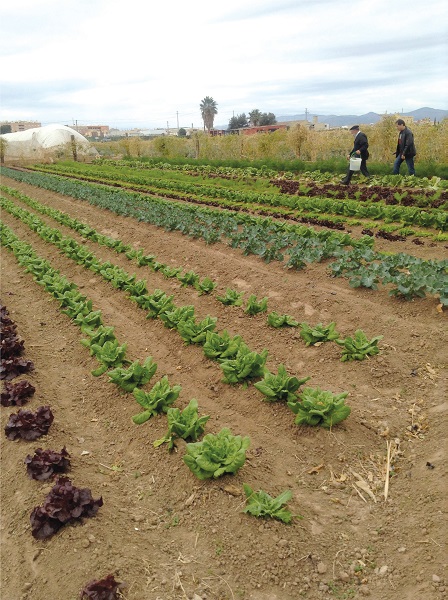To truly appreciate paella in Valencia, one must witness its making in a farmhouse | ABS-CBN

Welcome, Kapamilya! We use cookies to improve your browsing experience. Continuing to use this site means you agree to our use of cookies. Tell me more!
To truly appreciate paella in Valencia, one must witness its making in a farmhouse
To truly appreciate paella in Valencia, one must witness its making in a farmhouse
Jennie Celdran
Published Apr 29, 2019 07:41 PM PHT
Overshadowed by its more glamorous neighbor to the north, Valencia is usually left out of most travel itineraries. Which is unfortunate. With its cloudless blue skies, orange trees, and Mediterranean shoreline, Spain’s third largest city is worth the extra stop. Valencia is a mix of old and new, its Arab, Jewish, and Christian heritage combining seamlessly with modern representations like the sprawling architectural gem, the City of Arts and Sciences. Valencia really comes alive in March when the city celebrates Las Fallas Festival, the famous yearly event to welcome spring.
Overshadowed by its more glamorous neighbor to the north, Valencia is usually left out of most travel itineraries. Which is unfortunate. With its cloudless blue skies, orange trees, and Mediterranean shoreline, Spain’s third largest city is worth the extra stop. Valencia is a mix of old and new, its Arab, Jewish, and Christian heritage combining seamlessly with modern representations like the sprawling architectural gem, the City of Arts and Sciences. Valencia really comes alive in March when the city celebrates Las Fallas Festival, the famous yearly event to welcome spring.
Of course, paella is Valencia’s other claim to fame. Although viewed worldwide as a Spanish dish, paella is strictly regional. It originated in Valencia and no other region in Spain will dare claim it makes better paella than the Valencians.
Of course, paella is Valencia’s other claim to fame. Although viewed worldwide as a Spanish dish, paella is strictly regional. It originated in Valencia and no other region in Spain will dare claim it makes better paella than the Valencians.
The dish was developed after the Arabs brought in the three varieties of rice used for paella: bomba, senia, and bahia. They were planted in the Albufera, the wetlands of Valencia, and the farmers themselves invented the stew of rice combined with local products.
The dish was developed after the Arabs brought in the three varieties of rice used for paella: bomba, senia, and bahia. They were planted in the Albufera, the wetlands of Valencia, and the farmers themselves invented the stew of rice combined with local products.
You may also like:
You may also like:
ADVERTISEMENT
Paella takes its name from the large flat pan it is cooked in, the paellera. To appreciate the art of cooking paella, you must see it up close. In Valencia, several baraccas or traditional farmhouses offer the pleasure of this experience.
Paella takes its name from the large flat pan it is cooked in, the paellera. To appreciate the art of cooking paella, you must see it up close. In Valencia, several baraccas or traditional farmhouses offer the pleasure of this experience.
Baracca Toni Montoliu is one such place. Located in the Huerta Valenciana or the green belt that surrounds the city, this cooking school and restaurant is owned by the charismatic Toni Montoliu. Toni is a full-blooded Valencian and his sprawling farm with its wonderfully preserved baraccas is where his family has lived and worked the land for over five generations.
Baracca Toni Montoliu is one such place. Located in the Huerta Valenciana or the green belt that surrounds the city, this cooking school and restaurant is owned by the charismatic Toni Montoliu. Toni is a full-blooded Valencian and his sprawling farm with its wonderfully preserved baraccas is where his family has lived and worked the land for over five generations.
Toni advocates farm-to-table cooking. Everything that goes into his paella comes from his farm: bomba rice, chicken, rabbit, snails, olive oil, three kinds of beans (garrofo, tavella, and ferradura), tomato puree, good olive oil, a clove of garlic, paprika, saffron threads, salt, and a sprig of rosemary.
Toni advocates farm-to-table cooking. Everything that goes into his paella comes from his farm: bomba rice, chicken, rabbit, snails, olive oil, three kinds of beans (garrofo, tavella, and ferradura), tomato puree, good olive oil, a clove of garlic, paprika, saffron threads, salt, and a sprig of rosemary.
In an outdoor kitchen beneath barren winter trees, Toni began his cooking lesson by pouring wine for everyone gathered. He used logs from his orange trees to coax a large blaze, the smoke meant to infuse his paella with another layer of flavor. As Toni locked in the flavors of the chicken and rabbit, he reduced the intensity of the flames to allow the meat to cook through. Then, after more adjustments to the fire, he pushed the meat to the side and added the beans, garlic, tomato puree, paprika, and about a pitcher of water. When the water came to a boil, he introduced the rice, snails, and saffron threads. At this point, he stopped all stirring. The rice was allowed to sit and absorb the flavors undisturbed.
In an outdoor kitchen beneath barren winter trees, Toni began his cooking lesson by pouring wine for everyone gathered. He used logs from his orange trees to coax a large blaze, the smoke meant to infuse his paella with another layer of flavor. As Toni locked in the flavors of the chicken and rabbit, he reduced the intensity of the flames to allow the meat to cook through. Then, after more adjustments to the fire, he pushed the meat to the side and added the beans, garlic, tomato puree, paprika, and about a pitcher of water. When the water came to a boil, he introduced the rice, snails, and saffron threads. At this point, he stopped all stirring. The rice was allowed to sit and absorb the flavors undisturbed.
As Toni cooked, he remained jovial and talked nonstop. Again, he adjusted the flame so that the smoke enveloped the giant paellera. Satisfied and without skipping a beat, he grabbed an empty pail and gestured to those watching the demonstration to follow his lead. As the paella cooked, we went out to the field and began filling the bucket with lettuce, cabbage, and broccoli we ourselves picked. When Toni gestured again that we should return to our simmering dish, he knew, without a wristwatch or a kitchen timer, that the paella was ready.
As Toni cooked, he remained jovial and talked nonstop. Again, he adjusted the flame so that the smoke enveloped the giant paellera. Satisfied and without skipping a beat, he grabbed an empty pail and gestured to those watching the demonstration to follow his lead. As the paella cooked, we went out to the field and began filling the bucket with lettuce, cabbage, and broccoli we ourselves picked. When Toni gestured again that we should return to our simmering dish, he knew, without a wristwatch or a kitchen timer, that the paella was ready.
We sat at a long table outdoors, the temperature dropping but our insides warmed by homemade beer. Two men carried the paellera, which was about three feet in diameter, to where we sat. The smell was heavenly and the paella looked delicious garnished with a large sprig of fresh rosemary. We were given spoons so we could eat the paella the traditional way: communally and straight from the pan!
We sat at a long table outdoors, the temperature dropping but our insides warmed by homemade beer. Two men carried the paellera, which was about three feet in diameter, to where we sat. The smell was heavenly and the paella looked delicious garnished with a large sprig of fresh rosemary. We were given spoons so we could eat the paella the traditional way: communally and straight from the pan!
Each smoky mouthful was a delight, from the tender and juicy meat of the rabbit and chicken, to the earthy taste of the snails, the crunch of the beans, the fat morsels of saffron- and paprika-flavored rice, to the prized socarrat or burnt rice stuck to the bottom of the pan. We all dug in for more.
Each smoky mouthful was a delight, from the tender and juicy meat of the rabbit and chicken, to the earthy taste of the snails, the crunch of the beans, the fat morsels of saffron- and paprika-flavored rice, to the prized socarrat or burnt rice stuck to the bottom of the pan. We all dug in for more.
This story first appeared on Vault Magazine Issue 14 No 2 2014.
ADVERTISEMENT
ADVERTISEMENT







